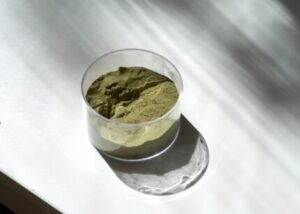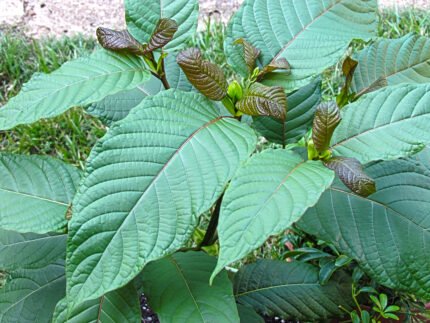Medically reviewed by Dr. Ramesh Gaddam, M.D. — Written by Sumalatha, D.N.H.E
Table of Contents
ToggleKratom, derived from the leaves of the Mitragyna speciosa tree native to Southeast Asia, is gaining popularity for its potential health benefits.
Traditionally used in herbal medicine, kratom offers a range of effects due to its active compounds, mitragynine and 7-hydroxymitragynine.
These alkaloids can provide pain relief, enhance mood, boost energy, and alleviate symptoms of opioid withdrawal.
While anecdotal evidence supports its benefits, scientific research is ongoing to fully understand its efficacy and safety.

1. Kratom Nutrition
The nutritional profile of kratom leaves per 100 grams:
| Nutrient | Amount per 100 grams |
|---|---|
| Calories | 250 kcal |
| Protein | 15 g |
| Fat | 2 g |
| Carbohydrates | 42 g |
| Fiber | 9 g |
| Calcium | 180 mg |
| Phosphorus | 120 mg |
| Potassium | 2,000 mg |
| Iron | 40 mg |
| Vitamin C | 20 mg |
| Vitamin A | 70 IU |
2. Health Benefits of Kratom
Kratom, a herbal extract from the leaves of the Mitragyna speciosa tree, has been traditionally used for its potential health benefits.
Its primary active compounds, mitragynine and 7-hydroxymitragynine, interact with opioid receptors in the brain, offering a range of effects:
Pain Relief:
Kratom is often used as an analgesic to alleviate chronic pain, particularly in conditions like arthritis and fibromyalgia.
Mood Enhancement:
It can improve mood and provide a sense of well-being, helping to reduce symptoms of anxiety and depression.
Energy Boost:
At lower doses, kratom acts as a stimulant, enhancing energy levels, focus, and alertness.
Opioid Withdrawal Aid:
Kratom has been utilized to manage withdrawal symptoms in individuals recovering from opioid addiction, reducing cravings and easing discomfort.
Anti-inflammatory:
Its anti-inflammatory properties can help reduce inflammation and related conditions.
Improved Sleep:
Higher doses of kratom can have sedative effects, promoting better sleep quality.
While anecdotal evidence supports these benefits, more rigorous scientific research is needed to validate and understand the long-term effects and safety of kratom use.
3. Uses of Kratom

Kratom has a variety of uses, rooted in both traditional practices and contemporary applications. Here are some common uses of kratom:
Pain Management:
Kratom is widely used for its analgesic properties to manage chronic pain conditions such as arthritis, fibromyalgia, and back pain.
Energy and Stamina Boost:
In lower doses, kratom acts as a stimulant, enhancing energy levels, physical endurance, and mental clarity, making it popular among laborers in Southeast Asia.
Mood Enhancement:
Kratom can improve mood, reduce anxiety, and alleviate symptoms of depression, offering a sense of well-being.
Opioid Withdrawal Relief:
It is used to ease withdrawal symptoms for those recovering from opioid addiction by mimicking some of the effects of opioids without the same level of risk.
Sedative Effects:
At higher doses, kratom can induce relaxation and sedation, helping with insomnia and promoting better sleep quality.
Cognitive Enhancement:
Some users report improved focus, concentration, and mental clarity with kratom use.
Recreational Use:
Due to its euphoric effects, kratom is also used recreationally to achieve a state of mild euphoria and relaxation.
While kratom has potential benefits, it’s important to use it responsibly and be aware of possible side effects and the need for further scientific validation of its safety and efficacy.
4. Forms of Kratom
Kratom is available in several forms, each offering different methods of consumption and varying effects. Here are the common forms of kratom:
Powder:
Kratom leaves are dried and ground into a fine powder. This is one of the most popular forms, as it can be easily mixed with liquids, added to food, or taken in capsule form.
Capsules:
Kratom powder is encapsulated for convenience, allowing for precise dosing and easy consumption without the need to taste the bitter flavor of kratom powder.
Extracts:
These are concentrated forms of kratom, where the active compounds are extracted from the leaves. Extracts come in various strengths and can be found as liquids, powders, or resins.
Tinctures:
Liquid extracts of kratom that are typically alcohol-based. They are highly concentrated and are usually taken by placing a few drops under the tongue or adding them to a beverage.
Leaves:
Fresh or dried kratom leaves can be chewed directly, which is a traditional method of consumption in Southeast Asia. Dried leaves can also be used to make tea.
Tea:
Kratom tea is made by brewing dried kratom leaves or powder in hot water. This method allows for the active compounds to be extracted into the water, providing a soothing way to consume kratom.
Resin:
A highly concentrated form of kratom made by boiling the leaves down to a thick, sticky substance. Resin can be used in small amounts due to its potency.
Tablets:
Similar to capsules, kratom tablets contain compressed powder and offer a convenient way to measure and consume kratom.
Each form of kratom has its own set of advantages and can be chosen based on personal preference, desired effects, and convenience.
5. Potential Side Effects of Kratom

Kratom use can lead to various side effects, especially with prolonged or high-dose consumption. Some of the common side effects include:
Nausea and Vomiting:
These are among the most frequently reported adverse effects of kratom, particularly with higher doses.
Constipation:
Kratom can slow down bowel movements, leading to constipation in some users.
Dry Mouth:
Users often experience a dry mouth, also known as “cottonmouth,” as a common side effect of kratom use.
Drowsiness:
Higher doses of kratom can cause sedation and drowsiness, which may affect alertness and coordination.
Loss of Appetite:
Some users report a decreased appetite with regular kratom use.
Insomnia:
While kratom can promote sleep at higher doses, it may cause insomnia in some users, especially at lower doses or with irregular use.
Increased Urination:
Frequent urination is a reported side effect of kratom use, which can potentially lead to dehydration if not managed properly.
Liver Toxicity:
Although rare, there are reports of liver damage associated with prolonged and excessive use of kratom.
Dependency and Withdrawal:
Regular use of kratom can lead to physical dependence, with withdrawal symptoms including irritability, mood swings, muscle aches, and cravings upon cessation.
Seizures:
In rare cases, high doses of kratom have been linked to seizures.
Cardiovascular Issues:
Some users have reported elevated heart rate and blood pressure with kratom use, particularly at higher doses.
Given these potential side effects, it is important to approach kratom use with caution, seek medical advice when necessary, and be aware of the need for more comprehensive research into its long-term health impacts.
Kratom use has been associated with potential liver toxicity, although such cases are relatively rare and often involve chronic use or high doses. Here are some effects of kratom on the liver:
Hepatotoxicity:
There have been reports of kratom-induced liver injury, characterized by jaundice (yellowing of the skin and eyes), dark urine, and elevated liver enzymes.
Symptoms typically appear within a few weeks of regular kratom use.
Cholestatic Injury:
Some users have experienced cholestasis, a condition where bile flow from the liver is reduced or blocked, leading to liver inflammation and damage.
Hepatitis:
Cases of acute hepatitis, an inflammatory condition of the liver, have been reported in some kratom users. This condition can cause liver enlargement, pain in the upper right abdomen, and significant fatigue.
Liver Failure:
In severe instances, prolonged and excessive use of kratom has been linked to acute liver failure, necessitating urgent medical intervention.
The exact mechanism of kratom’s hepatotoxic effects is not well understood, but it is believed that certain alkaloids in kratom may be metabolized into toxic compounds that can damage liver cells.
Summary:
It is important to approach kratom use with caution, monitor for any signs of liver distress, and seek medical advice if symptoms of liver damage occur.
Further research is needed to fully understand the extent and mechanisms of kratom’s effects on the liver.
7. Risk Factors of Kratom
Kratom, while touted for its potential benefits, also carries certain risks that users should be aware of. Here are some key risk factors associated with kratom use:
Dependency and Withdrawal:
Regular use of kratom can lead to physical dependence, characterized by withdrawal symptoms such as irritability, anxiety, nausea, and muscle aches upon cessation.
Potential for Addiction:
Due to its interaction with opioid receptors in the brain, kratom can be habit-forming, leading to addictive behaviors in some individuals.
Adverse Effects on Liver:
There have been reports of kratom-induced liver injury, although these cases are rare. Symptoms may include jaundice, dark urine, and abdominal pain.
Cardiovascular Effects:
Kratom has been associated with increased heart rate, high blood pressure, and palpitations, particularly at higher doses.
Gastrointestinal Issues:
Common side effects include nausea, vomiting, constipation, and dry mouth, especially with higher doses or prolonged use.
Cognitive Effects:
High doses of kratom can cause dizziness, drowsiness, confusion, and impaired coordination, posing risks, especially when driving or operating machinery.
Interactions with Medications:
Kratom can interact with other medications, potentially causing adverse reactions or reducing the effectiveness of prescription drugs.
Contamination and Quality Issues:
Kratom products sold online or in unregulated markets may be contaminated with other substances or have inconsistent potency, raising safety concerns.
Legal Status and Regulatory Issues:
The legal status of kratom varies by country and region, with some places banning its sale or use due to safety concerns and lack of regulatory oversight.
Lack of Research:
Despite its growing popularity, there is limited scientific research on the long-term effects, safety profile, and efficacy of kratom for various uses
Given these risk factors, it is important for individuals considering kratom use to weigh the potential benefits against the risks, use it responsibly, and seek medical advice if necessary, especially if managing chronic health conditions or taking other medications.
8. Does Kratom helps with Inflammation?
Kratom has been reported to have anti-inflammatory properties, which can help reduce inflammation and its related symptoms.
The key active compounds in kratom, mitragynine and 7-hydroxymitragynine, are believed to interact with the body’s opioid receptors and other pathways that modulate inflammation.
Here are some ways in which kratom might help with inflammation:
Pain Relief:
By reducing inflammation, kratom can alleviate pain associated with inflammatory conditions such as arthritis, fibromyalgia, and other chronic pain disorders.
Reduction of Swelling:
Kratom’s anti-inflammatory effects can help decrease swelling and redness in affected areas, improving mobility and function.
Immune System Modulation:
Some studies suggest that kratom may have immune-boosting properties, which can help the body manage inflammatory responses more effectively.
Antioxidant Activity:
Kratom contains several antioxidants that can help protect cells from oxidative stress, which often accompanies inflammation and can exacerbate its effects.
While anecdotal evidence and preliminary studies indicate that kratom may help with inflammation, more comprehensive scientific research is necessary to fully understand its efficacy and safety for this use.
As with any supplement, it is important to use kratom responsibly and consult with a healthcare professional before starting any new treatment for inflammatory conditions.
9. Does kratom help brain function?
Kratom has been reported by some users to help with certain aspects of brain function, such as enhancing focus, improving mood, and reducing anxiety. However, scientific evidence on these effects is limited and mixed.
Here are some potential ways kratom may influence brain function:
Enhanced Focus and Concentration:
At lower doses, kratom acts as a stimulant, which may help improve alertness, concentration, and mental clarity. Some users report increased productivity and cognitive performance.
Mood Improvement:
Kratom’s interaction with opioid receptors in the brain can lead to feelings of euphoria and well-being, potentially reducing symptoms of depression and anxiety. This mood enhancement can indirectly benefit cognitive function by improving mental state.
Anxiety Reduction:
Kratom’s calming effects can help reduce anxiety levels, which may improve cognitive function by alleviating stress-related cognitive impairments.
Energy Boost:
The stimulant properties of kratom at low doses can provide an energy boost, potentially enhancing mental and physical performance.
Summary:
While these anecdotal reports suggest that kratom may have positive effects on brain function, it is important to approach these claims with caution. The scientific community has yet to conduct comprehensive studies to confirm these effects and understand the underlying mechanisms.
Additionally, regular or high-dose use of kratom can lead to adverse effects such as dependency, cognitive impairment, and other health risks.
Given the potential for side effects and the lack of extensive research, it is advisable to use kratom responsibly and consult with a healthcare professional before using it for cognitive enhancement or any other purpose.
Frequently Asked Questions (FAQs)
Is Kratom a Serotonin?
No, kratom is not serotonin. Kratom is derived from the leaves of the Mitragyna speciosa tree and contains active compounds called alkaloids, primarily mitragynine and 7-hydroxymitragynine.
These alkaloids interact with opioid receptors in the brain, but they do not directly interact with serotonin receptors.
However, their interaction with the brain’s opioid receptors can indirectly influence mood and emotional states, which can affect serotonin levels.
Metabolism of Kratom
The metabolism of kratom primarily involves the liver, where its alkaloids are processed. Here’s a summary of the metabolic pathway:
- Absorption: Kratom is typically absorbed through the gastrointestinal tract when taken orally.
- First-Pass Metabolism: After absorption, kratom’s active compounds undergo first-pass metabolism in the liver.
- Enzymatic Breakdown: The primary enzymes involved in the metabolism of kratom are cytochrome P450 enzymes, particularly CYP3A4, CYP2D6, and CYP2C9. These enzymes help to metabolize mitragynine and 7-hydroxymitragynine into various metabolites.
- Excretion: The metabolites are then excreted from the body primarily through urine.
The metabolic process can vary based on individual factors such as genetics, liver function, and concurrent use of other substances that might inhibit or induce cytochrome P450 enzymes.
Does Kratom Raise Triglycerides?
There is limited scientific research on the direct impact of kratom on triglyceride levels.
Most available information on kratom focuses on its effects on pain, mood, and opioid withdrawal symptoms, with less attention to its effects on lipid metabolism or cardiovascular health.
Therefore, it is not conclusively known whether kratom raises triglyceride levels.
However, it’s important to consider that the lack of comprehensive studies means potential effects on triglycerides and other aspects of metabolic health cannot be ruled out.
If you are concerned about your triglyceride levels or other aspects of your health while using kratom, it is advisable to consult a healthcare professional for personalized advice and monitoring.
Also Read:
Medically reviewed by Dr. Ramesh Gaddam, M.D.

General Physician, Diabetologist, and Critical Care Specialist.
Related
Discover more from Health Build-Up
Subscribe to get the latest posts sent to your email.

